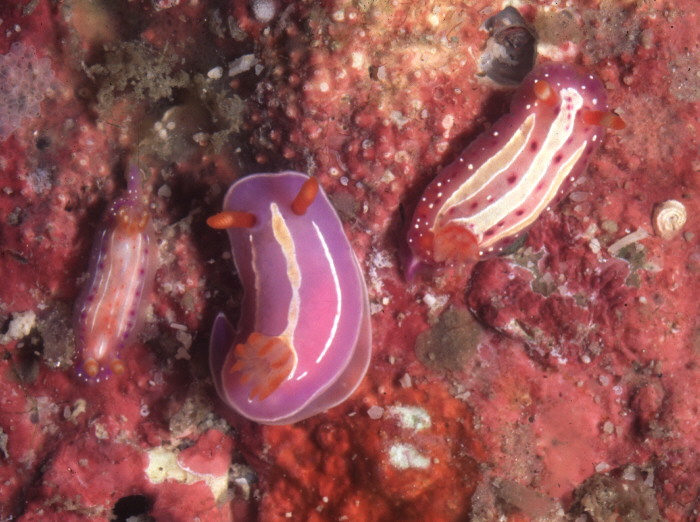 |
Pectenodoris aurora ,Johnson and Gosliner, 1998
Family Chromodorididae
Believe it or not, there are three species and two genera represented in the photo. The subjects, from left to right are Hypselodoris maculosa, Pectenodoris trilineata, and the new species, Pectenodoris aurora. These beautiful animals were photographed at 22m depth in the Philippines. Researchers have been hypothesizing about the color patterns of nudibranchs for years, and from this photo it is easy to understand why. Species with similar color patterns that are not closely related are often found in sympatry (living in the same place). It is thought that these similarly colored animals may form mimicry complexes, like snakes and butterflies. Mimicry theories are based on the idea that because many nudibranchs are locally rare they have evolved similar color patterns with their neighbors. These patterns help fish, and other visual predators “remember” that the nudibranchs are toxic (Most nudibranchs have some sort of defensive glands or structures to deter predation). The more times a fish encounters a horrible tasting nudibranch, the more likely it is not to try to eat animal it associates with a bad experience, including animals that look the same. So, by having the same or similar color patterns as their neighbors, rare nudibranchs have a kind of strength in numbers, even if the numbers aren’t their relatives. In this photo you can see the common pattern shared by H. maculosa and P. aurora. You can also see the three lined pattern shared by P. aurora and P. trilineata.
Citations
Terrence M. Gosliner and David W. Behrens. 1990 Special resemblance, aposematic coloration and mimicry in opisthobranch gastropods.
In Adaptive Coloration in Invertebrates
Proceedings of a Symposium sponsored by the American Society of Zoologists.
Mary Wicksten, compiler. College Station, Texas: Texas A&M University Sea Grant College Program 1990
Webmaster's note: Pectenodoris trilineata evidently is subject to some color and spatial variation in the three lined pattern on the dorsum as seen by the accompanying comparison of specimens collected in Indonesia and the Philippines.
Taxonomic text courtesy of Rebecca Johnson
Photos courtesy of Dr. Terry Gosliner

Rebecca is currently a graduate student in Terry Gosliner’s lab, working at both San Francisco State University and the California Academy of Sciences. She became interested in nudibranchs after taking a field course held at the University of California, Gump Biological Station in Moorea, French Polynesia. She is interested in using phylogenetic systematics to the form hypotheses of relationship (family trees) of these animals, and using the resulting trees as frameworks for exploring the evolution of color patterns in chromodorid nudibranchs.
Send Rebecca email at rjohnson@cas.calacademy.org
|
© The Slug Site, Michael D. Miller 1998 All Rights Reserved.
